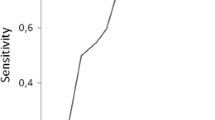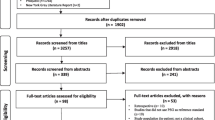Abstract
Purpose
The variations in reported prevalence of rapid eye movement-related obstructive sleep apnoea (REM-OSA) have been attributed to different definitions, although the effect of hypopnoea criteria has not been previously investigated.
Methods
Within this retrospective study, 134 of 382 consecutive patients undertaking polysomnography (PSG) for the suspicion of OSA met the inclusion criteria. PSGs were scored using both the 2007 AASM recommended hypopnoea criteria (AASM2007Rec) and the 2012 AASM recommended hypopnoea criteria (AASM2012Rec). For each hypopnoea criteria, REM-OSA patients were grouped as REM-related [either as REM-predominant OSA (rpOSA) or REM-isolated OSA (riOSA)] or non-stage-specific OSA (nssOSA). Outcome measures (SF-36, FOSQ and DASS-21) were also compared between groups.
Results
Incorporation of the AASM2012Rec criteria compared to the AASM2007Rec criteria increased the apnoea-hypopnoea index (AHI) for NREM and REM sleep but decreased the AHIREM/AHINREM ratio from 1.9 to 1.3 (p < 0.001). It also decreased the prevalence of riOSA [15.7 vs 2.2% (p < 0.001) for AASM2007Rec and AASM2012Rec, respectively]. The prevalence of rpOSA remained the same for each hypopnoea criteria although the prevalence of nssOSA increased with the AASM2012Rec hypopnoea criteria [53.0 vs 66.4% (p < 0.006) for AASM2007Rec and AASM2012Rec, respectively]. There were no differences in clinical symptoms between the groups, irrespective of hypopnoea criteria used.
Conclusions
This study demonstrates that in comparison with AASM2007Rec, the AASM2012Rec hypopnoea criteria reduce the prevalence of riOSA but not rpOSA by reducing the ratio of REM respiratory events and NREM respiratory events.

Similar content being viewed by others
References
Mokhlesi B, Punjabi NM (2012) “REM-related” obstructive sleep apnea: an epiphenomenon or a clinically important entity? Sleep 35:5–7. doi:10.5665/sleep.1570
Findley LJ, Wilhoit SC, Suratt PM (1985) Apnea duration and hypoxemia during REM sleep in patients with obstructive sleep apnea. Chest 87:432–436
Somers VK, Dyken ME, Clary MP, Abboud FM (1995) Sympathetic neural mechanisms in obstructive sleep apnea. J Clin Invest 96:1897–1904. doi:10.1172/JCI118235
Douglas NJ, White DP, Weil JV et al (1982) Hypercapnic ventilatory response in sleeping adults. Am Rev Respir Dis 126:758–762. doi:10.1164/arrd.1982.126.5.758
White DP, Douglas NJ, Pickett CK et al (1982) Hypoxic ventilatory response during sleep in normal premenopausal women. Am Rev Respir Dis 126:530–533. doi:10.1164/arrd.1982.126.3.530
Chami HA, Baldwin CM, Silverman A et al (2010) Sleepiness, quality of life, and sleep maintenance in REM versus non-REM sleep-disordered breathing. Am J Respir Crit Care Med 181:997–1002. doi:10.1164/rccm.200908-1304OC
Chami HA, Gottlieb DJ, Redline S, Punjabi NM (2015) Association between glucose metabolism and sleep-disordered breathing during REM sleep. Am J Respir Crit Care Med 192:1118–1126. doi:10.1164/rccm.201501-0046OC
Mokhlesi B, Hagen EW, Finn LA et al (2015) Obstructive sleep apnoea during REM sleep and incident non-dipping of nocturnal blood pressure: a longitudinal analysis of the Wisconsin Sleep Cohort. Thorax 70:1062–1069. doi:10.1136/thoraxjnl-2015-207231
Oksenberg A, Arons E, Nasser K et al (2010) REM-related obstructive sleep apnea: the effect of body position. J Clin Sleep Med 6:343–348
Joosten SA, Hamza K, Sands S et al (2012) Phenotypes of patients with mild to moderate obstructive sleep apnoea as confirmed by cluster analysis. Respirology 17:99–107. doi:10.1111/j.1440-1843.2011.02037.x
Koo BB, Patel SR, Strohl K, Hoffstein V (2008) Rapid eye movement-related sleep-disordered breathing: influence of age and gender. Chest 134:1156–1161. doi:10.1378/chest.08-1311
Conwell W, Patel B, Doeing D et al (2012) Prevalence, clinical features, and CPAP adherence in REM-related sleep-disordered breathing: a cross-sectional analysis of a large clinical population. Sleep Breath 16:519–526. doi:10.1007/s11325-011-0537-6
Moser NJ, Phillips BA, Berry DT, Harbison L (1994) What is hypopnea, anyway? Chest 105:426–428
Iber C, Ancoli-Israel S, Chesson AL, Quan SF (2007) AASM manual for the scoring of sleep and associated events: rules, terminology and technical specifications, 1st edn. American Academy of Sleep Medicine, Westchester
Berry RB, Brooks R, Gamaldo CE, et al (2012) The AASM Manual for the Scoring of Sleep and Associated Events: Rules, Terminology and Technical Specifications. Darien
Duce B, Milosavljevic J, Hukins C (2015) The 2012 AASM respiratory event criteria increase the incidence of hypopneas in an adult sleep center population. J Clin Sleep Med 11:1425–1431. doi:10.5664/jcsm.5280
Berry RB, Gleeson K (1997) Respiratory arousal from sleep: mechanisms and significance. Sleep 20:654–675
Peppard PE, Ward NR, Morrell MJ (2009) The impact of obesity on oxygen desaturation during sleep-disordered breathing. Am J Respir Crit Care Med 180:788–793. doi:10.1164/rccm.200905-0773OC
Johns MW (1991) A new method for measuring daytime sleepiness: the Epworth sleepiness scale. Sleep 14:540–545. doi:10.1016/j.sleep.2007.08.004
Weaver TE, Laizner AM, Evans LK et al (1997) An instrument to measure functional status outcomes for disorders of excessive sleepiness. Sleep 20:835–843
Ware JEJ, Sherbourne CD (1992) The MOS 36-item short-form health survey (SF-36). I. Conceptual framework and item selection. Med Care 30:473–483
Lovibond PF, Lovibond SH (1995) The structure of negative emotional states: comparison of the depression anxiety stress scales (DASS) with the Beck depression and anxiety inventories. Behav Res Ther 33:335–343
D’Agostino R, Pearson ES (1973) Tests for departure from results for the normality of b2 and √b1. Biometrika 60:613–622. doi:10.2307/2335012
Freeman GH, Halton JH (1951) Note on exact treatment of contingency, goodness of fit and other problems of significance. Biometrika 38:141–149
Koo BB, Dostal J, Ioachimescu O, Budur K (2008) The effects of gender and age on REM-related sleep-disordered breathing. Sleep Breath 12:259–264. doi:10.1007/s11325-007-0161-7
Haba-Rubio J, Janssens JP, Rochat T, Sforza E (2005) Rapid eye movement-related disordered breathing: clinical and polysomnographic features. Chest 128:3350–3357. doi:10.1378/chest.128.5.3350
Lee S-A, Paek J-H, Han S-H (2016) REM-related sleep-disordered breathing is associated with depressive symptoms in men but not in women. Sleep Breath 20:995–1002. doi:10.1007/s11325-016-1323-2
Shepertycky MR, Banno K, Kryger MH (2005) Differences between men and women in the clinical presentation of patients diagnosed with obstructive sleep apnea syndrome. Sleep 28:309–314
Mosko SS, Dickel MJ, Ashurst J (1988) Night-to-night variability in sleep apnea and sleep-related periodic leg movements in the elderly. Sleep 11:340–348
Azeredo Bittencourt LR, Suchecki D, Tufik S et al (2001) The variability of the apnoea-hypopnoea index. J Sleep Res 10:245–251. doi:10.1046/j.1365-2869.2001.00255.x
American Academy of Sleep Medicine Task Force (1999) Sleep-related breathing disorders in adults: recommendations for syndrome definition and measurement techniques in clinical research. Sleep 22:667–689. doi:10.1378/chest.97.1.27
Steffen A, Maibücher L, König IR (2016) Supine position and REM dependence in obstructive sleep apnea. HNO 65:52–58. doi:10.1007/s00106-016-0265-0
Author information
Authors and Affiliations
Corresponding author
Ethics declarations
Financial support
Antti Kulkas is supported by the Emil Aaltonen and Tampere Tuberculosis Foundations, the Seinäjoki Central Hospital and the Competitive State Research Financing of Expert Responsibility Area of Tampere University Hospital grant VTR3221. The sponsors had no role in the design or conduct of this research.
Conflict of interest
All authors certify that they have no affiliations with or involvement in any organization or entity with any financial interest in the subject matter or materials discussed in this manuscript.
Ethical approval
The Institutional Human Research Ethics Committee of the Princess Alexandra Hospital approved this study (HREC/16/QPAH/021). All procedures performed in studies involving human participants were in accordance with the ethical standards of the institutional and/or national research committee and with the 1964 Helsinki declaration and its later amendments or comparable ethical standards. For this type of study, formal consent by the patients was not required.
Rights and permissions
About this article
Cite this article
Duce, B., Kulkas, A., Langton, C. et al. The prevalence of REM-related obstructive sleep apnoea is reduced by the AASM 2012 hypopnoea criteria. Sleep Breath 22, 57–64 (2018). https://doi.org/10.1007/s11325-017-1526-1
Received:
Revised:
Accepted:
Published:
Issue Date:
DOI: https://doi.org/10.1007/s11325-017-1526-1




